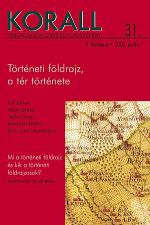„Kulturális hatóerőnk” mitikus történeti földrajzi háttere. A magyar Mezopotámia képzete
The Mythic Historico-Geographical Background for ‘Our Cultural Force’: The Notion of a Hungarian Mesopotamia
Author(s): Róbert KeményfiSubject(s): History
Published by: KORALL Társadalomtörténeti Egyesület
Summary/Abstract: During the period of the formation of the consciousness of national origins for ethnic and language-based proto-communities, and also later, in the period of modern nation-building, the historical consciousness of peoples entering this process late or without an independent statehood contained ideological systems through which they could date or trace the ‘vitality’ and primordiality of their own culture back to the ancient cradles of human civilization. It is this ideological framework where the notion called ‘Hungarian Mesopotamic idea’ belongs. This can be summed up as follows: the connections with ancient fluvial civilizations, including the Southern-Uralic areas around the Caspian Sea, Lake Aral, and the Tien-san (often identified as Turanian peoples), together with the Sumerian- Hungarian linguistic relationship derived from this ‘Turanian character’, have provided Hungarians with a secret forgotten knowledge that elevates them among the ranks of culture-creators generating a universal civilization. In this view, all social ‘concerns’ and historical tragedies derive from the fact that academic thinking, the Hungarian way of social development, and political decision makers have always failed/continue to fail to recognize this. The Hungarian nation would surely not ‘lag behind’ if this ‘ancient cultural force’, and ‘high civilization’ (e.g. the runic alphabet and writing) were reintroduced to help the nation to ascend again. However, it was not only in quasi-scholarly or ‘esoteric’ historiography where the Mesopotamic idea, refuted by relevant professional scholarly criticism, occurred. It also appeared in Hungarian geographical scholarship between the two world wars. This contained elements of the Hungarian ‘Turanian’ heritage, and mapped how the impact of the culture acquired there influenced spatial processes in a way that is still recognizable today. Moreover, beside this notion, Hungarian geography – a discipline not yet fully detailed and developed – made the Carpathian Basin itself seem to be a peculiar ‘Hungarian Mesopotamia’. This present study aims to describe the general characteristics of geographical mythopoeia, exploring how the idea of a ‘culture-generating natural environment’ appeared in Hungarian geographical scholarship between the two world wars. This is followed by a survey of early German research examples that served as a basis for this notion catching on in the Hungarian-speaking regions. Also included is a detailed discussion of what role this geographical Mesopotamic principle played in the ‘scholarly’ support of revisionist efforts surfacing in the inter-war period.
Journal: Korall - Társadalomtörténeti folyóirat
- Issue Year: 2008
- Issue No: 31
- Page Range: 101-131
- Page Count: 31
- Language: Hungarian

